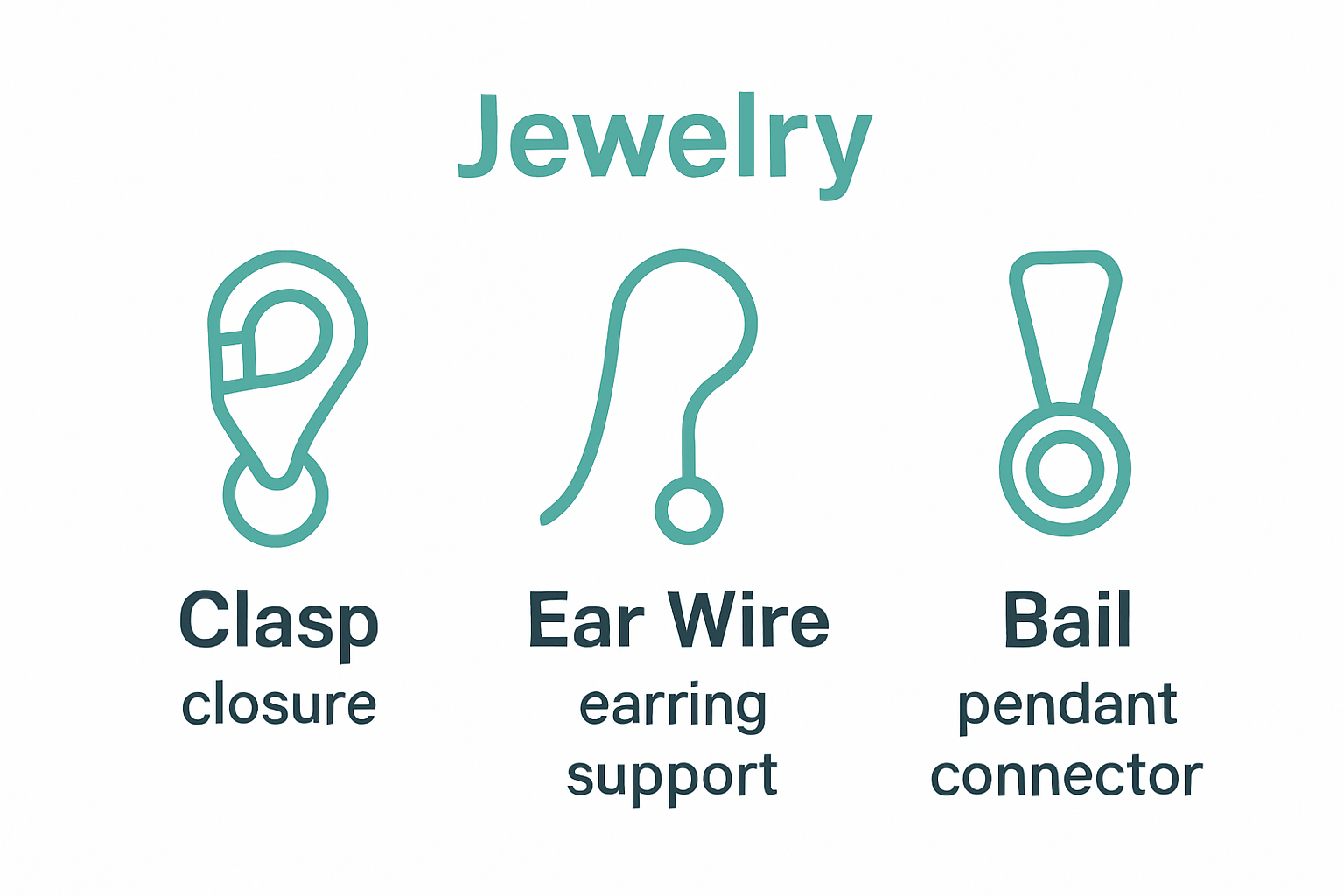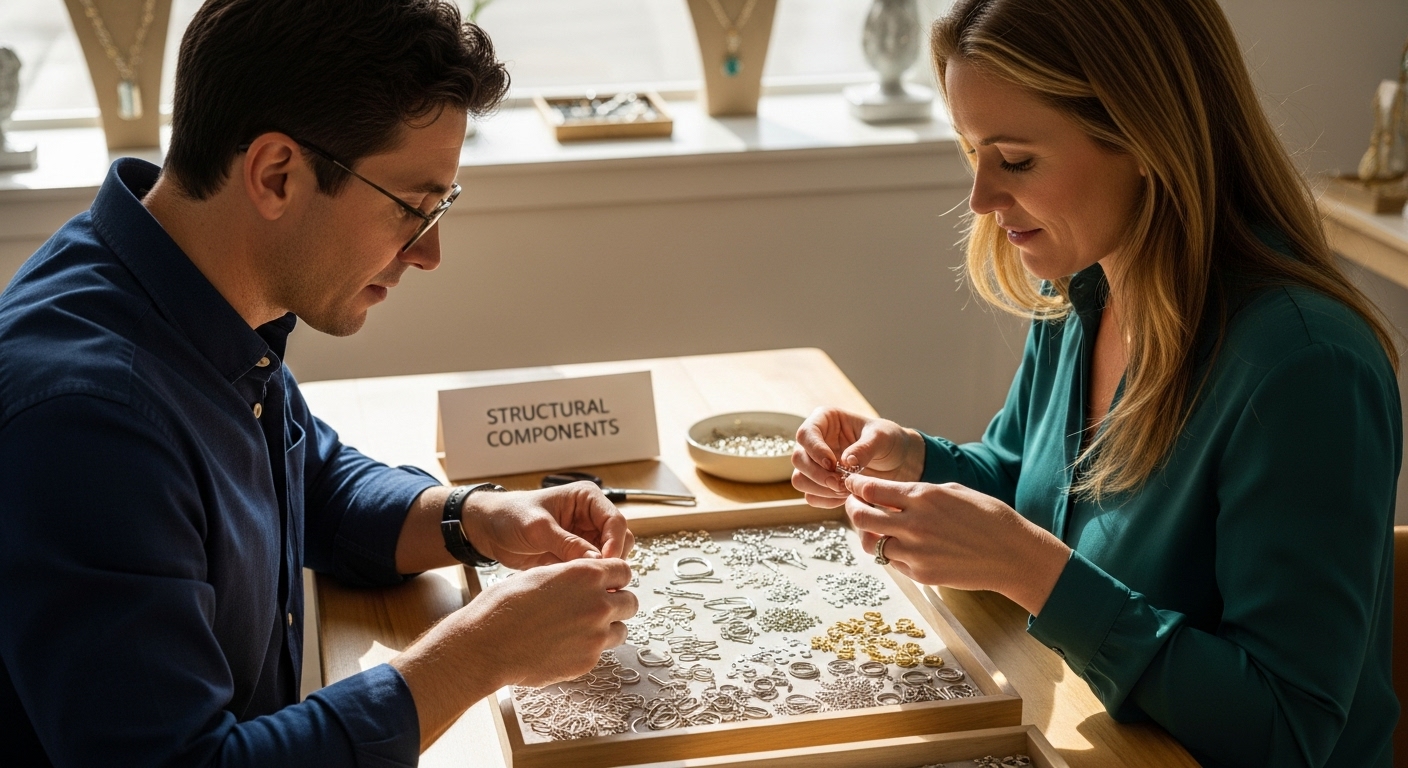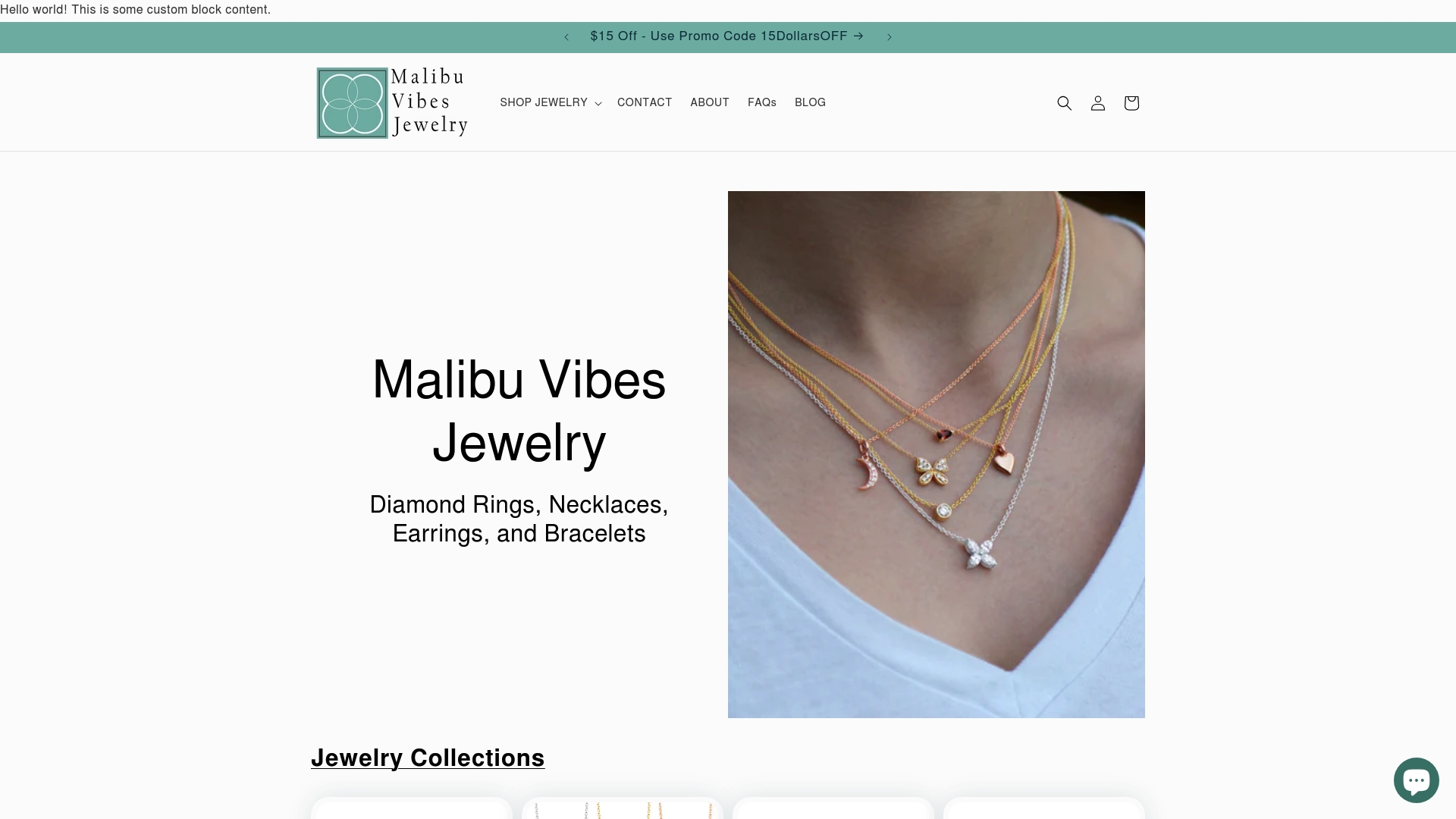Every piece of jewelry you wear relies on hidden components that dictate comfort, style, and durability. Most people admire the sparkle of a gemstone or the shine of metal, but they overlook the small, essential parts holding everything together. Jewelry findings make up the engineering backbone of each piece and can even determine how long your favorite necklace lasts or if those earrings stay attached—with some findings specifically designed to resist corrosion and preserve structural strength over years of daily use. Curious how these tiny pieces have such a massive impact? Keep reading.
Table of Contents
- Defining Jewelry Findings And Their Components
- The Importance Of Jewelry Findings In Design
- How Jewelry Findings Influence Quality And Durability
- Exploring Different Types Of Jewelry Findings
- Real-World Applications Of Findings In Jewelry Making
Quick Summary
| Takeaway | Explanation |
|---|---|
| Jewelry findings are essential components. | They are crucial for transforming jewelry elements into complete, wearable pieces, affecting functionality and design. |
| Material quality impacts durability. | The choice of metals and manufacturing techniques ensures longevity and resistance to wear in jewelry findings. |
| Precision in findings enhances aesthetic appeal. | Well-designed findings provide visual balance and support, contributing to the overall beauty of the jewelry. |
| Findings allow for innovative design flexibility. | Strategic usage of findings enables unique designs, adaptability, and customization in jewelry making. |
| Every finding dictates comfort and wearability. | The right selection ensures jewelry sits correctly, moves with the body, and remains comfortable throughout wear. |
Defining Jewelry Findings and Their Components
Jewelry findings represent the fundamental mechanical and functional components that transform individual jewelry elements into wearable, complete pieces. International Gemstone Society defines these specialized parts as critical connectors and structural elements that enable jewelry design and functionality.
Essential Structural Components
Findings encompass a wide range of precision-engineered hardware pieces that serve multiple crucial purposes in jewelry construction. These components include clasps, jump rings, ear wires, pin backs, bails, and connectors. Each finding plays a specific role in creating secure, comfortable, and visually appealing jewelry pieces.
Below is a table summarizing common types of jewelry findings and their primary functions, helping to clarify how each component supports jewelry construction and design.
| Finding Type | Primary Function | Typical Jewelry Pieces |
|---|---|---|
| Jump Ring | Flexible linking and connecting elements | Necklaces, bracelets, earrings |
| Split Ring | Secure attachment for charms or components | Charm bracelets, pendants |
| Lobster Clasp | Closure mechanism for secure fastening | Necklaces, bracelets |
| Spring Ring Clasp | Lightweight, circular closure for smaller pieces | Lightweight necklaces, anklets |
| Toggle Clasp | Decorative and functional closure | Bracelets, necklaces |
| Bail | Suspension of pendants from chains | Pendants, necklaces |
| Ear Wire/Leverback | Attaching and securing earrings to the ear | Earrings |
Key Characteristics of Jewelry Findings
- Engineered for precise mechanical connections
- Typically made from metals like sterling silver, gold, brass, or stainless steel
- Designed to be durable and resistant to wear
- Must complement the aesthetic of the primary jewelry piece
Manufacturing and Material Considerations
The quality of jewelry findings significantly impacts the overall durability and wearability of a piece. Professional jewelers and designers select findings based on specific criteria such as metal composition, strength, size, and visual harmony with the primary jewelry components.
This table highlights key factors that jewelers consider when selecting findings, illustrating the relationship between design, material quality, and jewelry performance.
| Consideration | Impact on Jewelry |
|---|---|
| Material Quality | Affects durability, resistance to corrosion, and longevity |
| Strength | Ensures secure construction and prevents breakage |
| Size and Proportion | Maintains aesthetic harmony and comfort |
| Visual Compatibility | Matches the look and feel of the main jewelry elements |
| Manufacturing Techniques | Determines precision, strength, and quality consistency |
| Customization Potential | Allows unique design expressions and versatility |
| Read more about our fine jewelry craftsmanship to understand how these intricate details contribute to exceptional jewelry design. |
While often overlooked by casual observers, findings represent the hidden engineering that transforms individual decorative elements into functional, wearable art. Their precise design ensures that necklaces drape correctly, earrings hang symmetrically, and bracelets connect smoothly, creating seamless and comfortable jewelry experiences.
The Importance of Jewelry Findings in Design
Jewelry findings are far more than mere functional components they are the critical design elements that transform individual materials into cohesive wearable art. According to Jewelry Design and Techniques, these small yet essential components play a pivotal role in determining the overall aesthetic, durability, and functionality of jewelry pieces.
Structural Integrity and Aesthetic Harmony
Findings serve as the architectural framework that connects and supports decorative elements.
They determine how a piece sits on the body, its movement, and its visual balance. Professional designers carefully select findings that not only provide structural support but also complement the artistic vision of the jewelry. Every finding contributes to the piece’s narrative and visual language.
Critical Design Considerations for Findings
- Visual proportion and aesthetic alignment
- Material compatibility with primary jewelry components
- Structural strength and durability
- Comfort and wearability
- Potential for customization and unique design expression
Technical and Creative Significance
Beyond their mechanical role, findings represent a critical junction between technical engineering and artistic expression. They allow designers to experiment with connection points, create innovative attachment methods, and introduce unexpected design elements. Explore our deep dive into jewelry design history to understand how these small components have evolved with artistic movements.
The strategic selection of findings can elevate a simple design into a sophisticated piece of wearable art. Whether it is a delicate ear wire that allows an earring to move gracefully or a complex bail that transforms a pendant’s entire character, findings are the unsung heroes of jewelry design that bridge technical functionality with artistic vision.
How Jewelry Findings Influence Quality and Durability
The quality and durability of jewelry are intrinsically linked to the precision and materials used in its findings. Gemological Institute of America emphasizes that these small components are critical in determining a piece’s longevity, performance, and overall structural integrity.
Material Selection and Performance
Findings directly impact a jewelry piece’s resilience and wearability. The selection of materials determines how well a piece withstands daily wear, environmental factors, and potential stress. Professional jewelers consider multiple factors when choosing findings, ensuring they match the primary materials in strength, corrosion resistance, and aesthetic compatibility.
Key Material Performance Factors
- Resistance to tarnishing and oxidation
- Tensile strength under repeated stress
- Compatibility with body chemistry
- Ability to maintain structural integrity
- Long-term color and finish preservation
Structural Reliability and Wear Resistance
The engineering of findings plays a crucial role in preventing jewelry failure. Precise manufacturing techniques, such as seamless soldering, robust connection points, and reinforced attachment mechanisms, significantly enhance a piece’s durability. Learn more about our commitment to fine jewelry craftsmanship to understand how meticulous design translates to superior jewelry quality.
Professional-grade findings undergo rigorous testing to ensure they can withstand repeated use, environmental challenges, and the natural movement of the human body. From ear wires that maintain their shape after countless wearings to clasps that securely hold necklaces without weakening, these small components are the unsung guardians of jewelry longevity.
Exploring Different Types of Jewelry Findings
International Gemstone Society identifies jewelry findings as specialized hardware components that serve distinct functions in jewelry design and construction. These precision-engineered elements vary widely in their specific purposes and applications.

Connection and Attachment Findings
Connection findings represent the critical infrastructure that joins different jewelry components together. These sophisticated hardware pieces enable designers to create complex, intricate pieces with seamless transitions. The most common connection findings include jump rings, which create flexible links between pendants and chains, and split rings that provide secure attachment points for charms and decorative elements.
Primary Connection Findings
- Jump rings for flexible linking
- Split rings for secure attachments
- Lobster clasps for necklace and bracelet closures
- Spring ring clasps for lightweight jewelry
- Toggle clasps for decorative and functional connections
Suspension and Hanging Findings
Suspension findings determine how decorative elements are displayed and positioned. Bails, for instance, serve as critical connectors that allow pendants to hang gracefully from chains. Different bail designs accommodate varying pendant sizes, shapes, and aesthetic requirements. Learn more about fashion jewelry design principles to understand how these small components influence overall jewelry aesthetics.
Ear findings represent another crucial category, with designs ranging from simple ear wires to complex leverback and clip-on mechanisms. These specialized components not only secure earrings but also contribute significantly to comfort, movement, and visual appeal. Professional jewelers meticulously select ear findings that complement both the earring design and the wearer’s individual style preferences.
Real-World Applications of Findings in Jewelry Making
Jewelry Manufacturing Institute reveals that findings are not just technical components but transformative elements that enable complex jewelry design and production techniques. These specialized hardware pieces bridge creative vision with practical wearability across various jewelry styles and manufacturing approaches.
Customization and Design Flexibility
Findings provide jewelers with extraordinary design flexibility, allowing them to create pieces that adapt to diverse aesthetic and functional requirements. Professional designers leverage these components to experiment with unique connection methods, movement dynamics, and visual transitions between different materials and elements.
Strategic Design Applications
- Enabling modular jewelry designs
- Creating interchangeable pendant systems
- Supporting complex layering techniques
- Facilitating mixed metal compositions
- Enhancing jewelry adaptability and versatility
Manufacturing and Production Techniques
In professional jewelry production, findings play a crucial role in streamlining manufacturing processes. Precision-engineered findings allow for standardized connection methods, reducing production time and ensuring consistent quality across different pieces. Explore our insights into gold jewelry investment to understand how technical components contribute to jewelry value.
From artisan workshops to large-scale production facilities, findings represent the invisible engineering that transforms raw materials into wearable art. They enable jewelers to create pieces that are not just visually stunning but also structurally sound, comfortable, and capable of withstanding daily wear while maintaining their original aesthetic integrity.

Experience Jewelry Crafted from Superior Findings and Lasting Materials
Understanding the importance of jewelry findings means you care about durability, comfort, and visual harmony in every piece you wear. One of the most common frustrations is investing in jewelry that loses its appeal when weak clasps, flimsy settings, or low-grade metals fail. You want something more than a beautiful design. You want lasting quality that you can trust for every occasion.
Explore our Solid Gold Necklaces collection to see how expertly engineered findings combine with the elegance of 14k gold for jewelry that lasts. Each piece is thoughtfully designed and handcrafted in Los Angeles, using premium materials for flawless connections and enduring beauty.

Elevate your standards and discover the hidden quality behind beautiful jewelry at Malibu Vibes Jewelry. Shop now to enjoy pieces that are not only stunning but also built to stand the test of time. If you are looking for settings that showcase intricate detail and security, do not miss our Bezel Jewelry collection. Experience the difference handpicked findings make. The style and strength you have been searching for is just a click away.
Frequently Asked Questions
What are jewelry findings?
Jewelry findings are specialized mechanical components that connect and support different parts of jewelry, transforming individual elements into complete wearable pieces. They include clasps, jump rings, ear wires, bails, and connectors.
Why are jewelry findings important in jewelry design?
Jewelry findings are crucial because they provide structural integrity, ensuring pieces are functional and comfortable. They also enhance the overall aesthetic and allow for unique design expressions by connecting various components seamlessly.
What materials are jewelry findings typically made from?
Jewelry findings are usually crafted from durable metals like sterling silver, gold, brass, or stainless steel. The choice of material affects the piece’s durability, resistance to wear, and aesthetic compatibility with the primary jewelry items.
How do findings influence the durability of jewelry?
The quality and design of jewelry findings significantly affect a piece’s durability. Findings must be engineered to withstand daily wear and environmental factors, ensuring structural integrity and preventing jewelry failure.
Recommended
- What is Fine Jewelry? Understanding Luxury and Craftsmanship – Malibu Vibes Jewelry
- What is Fashion Jewelry? Understanding Its Essence and Appeal – Malibu Vibes Jewelry
- Understanding the History of Jewelry Design and Its Impact – Malibu Vibes Jewelry
- Understanding Why Invest in Gold Jewelry: A Comprehensive Guide – Malibu Vibes Jewelry



